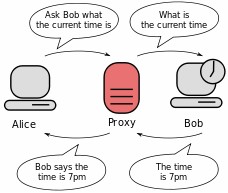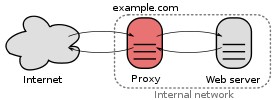Proxy Server
It is a server (a computer system or an application) that acts as an intermediary for requests from clients seeking resources from other servers. A client connects to the proxy server, requesting some service, such as a file, connection, web page, or other resource available from a different server and the proxy server evaluates the request as a way to simplify and control its complexity. Proxies were invented to add structure and encapsulation to distributed systems. Today, most proxies are web proxies, facilitating access to content on the World Wide Web and providing anonymity.

Types of proxy – A proxy server may reside on the user’s local computer, or at various points between the user’s computer and destination servers on the Internet.
- A proxy server that passes requests and responses unmodified is usually called a gateway or sometimes a tunneling proxy.
- A forward proxy is an Internet-facing proxy used to retrieve from a wide range of sources (in most cases anywhere on the Internet).
- A reverse proxy is usually an Internet-facing proxy used as a front-end to control and protect access to a server on a private network. A reverse proxy commonly also performs tasks such as load-balancing, authentication, decryption or caching.
Open proxies – An open proxy is a forwarding proxy server that is accessible by any Internet user. Gordon Lyon estimates there are “hundreds of thousands” of open proxies on the Internet. An anonymous open proxy allows users to conceal their IP address while browsing the Web or using other Internet services. There are varying degrees of anonymity however, as well as a number of methods of ‘tricking’ the client into revealing itself regardless of the proxy being used.

Reverse proxies – A reverse proxy (or surrogate) is a proxy server that appears to clients to be an ordinary server. Requests are forwarded to one or more proxy servers which handle the request. The response from the proxy server is returned as if it came directly from the original server, leaving the client no knowledge of the origin servers. Reverse proxies are installed in the neighborhood of one or more web servers. All traffic coming from the Internet and with a destination of one of the neighborhood’s web servers goes through the proxy server. The use of “reverse” originates in its counterpart “forward proxy” since the reverse proxy sits closer to the web server and serves only a restricted set of websites.

There are several reasons for installing reverse proxy servers
- Encryption / SSL acceleration: when secure web sites are created, the SSL encryption is often not done by the web server itself, but by a reverse proxy that is equipped with SSL acceleration hardware. See Secure Sockets Layer. Furthermore, a host can provide a single “SSL proxy” to provide SSL encryption for an arbitrary number of hosts; removing the need for a separate SSL Server Certificate for each host, with the downside that all hosts behind the SSL proxy have to share a common DNS name or IP address for SSL connections. This problem can partly be overcome by using the SubjectAltName feature of X.509 certificates.
- Load balancing: the reverse proxy can distribute the load to several web servers, each web server serving its own application area. In such a case, the reverse proxy may need to rewrite the URLs in each web page (translation from externally known URLs to the internal locations).
- Serve/cache static content: A reverse proxy can offload the web servers by caching static content like pictures and other static graphical content.
- Compression: the proxy server can optimize and compress the content to speed up the load time.
- Spoon feeding: reduces resource usage caused by slow clients on the web servers by caching the content the web server sent and slowly “spoon feeding” it to the client. This especially benefits dynamically generated pages.
- Security: the proxy server is an additional layer of defense and can protect against some OS and Web Server specific attacks. However, it does not provide any protection from attacks against the web application or service itself, which is generally considered the larger threat.
- Extranet Publishing: a reverse proxy server facing the Internet can be used to communicate to a firewall server internal to an organization, providing extranet access to some functions while keeping the servers behind the firewalls. If used in this way, security measures should be considered to protect the rest of your infrastructure in case this server is compromised, as its web application is exposed to attack from the Internet.
If the destination server filters content based on the origin of the request, the use of a proxy can circumvent this filter. For example, a server using IP-based geolocation to restrict its service to a certain country can be accessed using a proxy located in that country to access the service.
Web proxies are the most common means of bypassing government censorship, although no more than 3% of Internet users use any circumvention tools. In some cases users can circumvent proxies which filter using blacklists using services designed to proxy information from a non-blacklisted location.
Proxies can be installed in order to eavesdrop upon the data-flow between client machines and the web. All content sent or accessed – including passwords submitted and cookies used – can be captured and analyzed by the proxy operator. For this reason, passwords to online services (such as webmail and banking) should always be exchanged over a cryptographically secured connection, such as SSL. By chaining proxies which do not reveal data about the original requester, it is possible to obfuscate activities from the eyes of the user’s destination. However, more traces will be left on the intermediate hops, which could be used or offered up to trace the user’s activities. If the policies and administrators of these other proxies are unknown, the user may fall victim to a false sense of security just because those details are out of sight and mind. In what is more of an inconvenience than a risk, proxy users may find themselves being blocked from certain Web sites, as numerous forums and Web sites block IP addresses from proxies known to have spammed or trolled the site. Proxy bouncing can be used to maintain your privacy.
Anonymizer
An anonymizer or an anonymous proxy is a tool that attempts to make activity on the Internet untraceable. It is a proxy server computer that acts as an intermediary and privacy shield between a client computer and the rest of the Internet. It accesses the Internet on the user’s behalf, protecting personal information by hiding the client computer’s identifying information.
There are many reasons for using anonymizers. Anonymizers help minimize risk. They can be used to prevent identity theft, or to protect search histories from public disclosure. Some countries apply heavy censorship on the internet. Anonymizers can help in allowing free access to all of the internet content, but cannot help against persecution for accessing the Anonymizer website itself. Furthermore, as information itself about Anonymizer websites are banned in these countries, users are wary that they may be falling into a government-set trap.
Anonymizers are also used by people who wish to receive objective information with the growing target marketing on the internet and targeted information. For example, large news outlets such as CNN target the viewers according to region and give different information to different populations. Websites such as YouTube obtain information about the last videos viewed on a computer, and propose “recommended” videos accordingly, and most of the online targeted marketing is done by showing advertisements according to that region. Anonymizers are used for avoiding this kind of targeting and getting a more objective view of information.
Types
- Protocol specific anonymizers – Sometimes anonymizers are implemented to work only with one particular protocol. The advantage is that no extra software is needed. The operation occurs in this manner: A connection is made by the user to the anonymizer. Commands to the anonymizer are included inside a typical message. The anonymizer then makes a connection to the resource specified by the inbound command and relays the message with the command stripped out. An example of a protocol-specific anonymizer is an anonymous remailer for e-mail. Also of note are web proxies, and bouncers for FTP and IRC.
- Protocol independent anonymizers – Protocol independence can be achieved by creating a tunnel to an anonymizer. The technology to do so varies. Protocols used by anonymizer services may include SOCKS, PPTP, or OpenVPN. In this case either the desired application must support the tunneling protocol, or a piece of software must be installed to force all connections through the tunnel. Web browsers, FTP and IRC clients often support SOCKS for example, unlike telnet.
 Stay Ahead with the Power of Upskilling - Invest in Yourself!
Stay Ahead with the Power of Upskilling - Invest in Yourself! 

